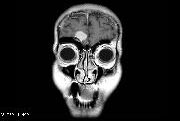Intracranial hypertension, also called pseudotumor cerebri, feels like a feeling of pressure
and throbbing behind the eyes every day. It may worsen over time. Sometimes the vision is
affected. The symptoms do not vary with the position of the body. There is no nausea or
sensitivity to light or sound.
Unlike other headaches, intracranial hypertension can be demonstrated by testing. For
many other kinds of headaches, test results are normal. For this kind of headache, some test
results are abnormal.
In the case of intracranial hypertension, a doctor may see something called papilledema.
This is swelling of the optic nerve behind the eye. When it is seen in the setting of headache,
it suggests intracranial hypertension is the cause. Normally MRI of the brain is ordered, and
it is normal in this case.
The next test that would be done is a spinal tap. The fluid tested with the spinal tap is called
CSF (cerebrospinal fluid). The chemistry of the fluid should be normal. The pressure of the
fluid should be elevated, often much more than normal. The CSF pressure is the pressure
that the fluid flows out at- this is usually greater than gravity.
Causes of intracranial hypertension include hormones (either from ovaries or fat cells, or
exogenous hormones taken for other reasons), and certain medications (minocycline which
is used for acne is a common cause).
Because medications may cause this disorder, treatment may simply be stopping the
offending agents. For other cases, certain medications such as acetazolamide and
furosemide can be helpful. When these do not work, the goal is to help save the vision.
Rarely, patients with this disorder are treated with optic nerve fenestration surgery. This
prevents the optic nerves from being injured by the elevated CSF pressure. In exceptional cases, a shunt surgery is done. This allows the extra CSF to flow to another part of the body
to reduce the elevated pressure.
What if these treatments do not help? First consider if the diagnosis is correct. Second,
consider if there is more than one type of headache. Although the headache due to raised
intracranial pressure can be demonstrated by spinal tap, it does not exclude the possibility
of other causes.
neurocuro
data for your mind
